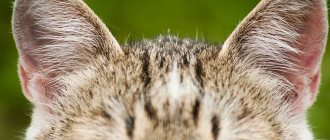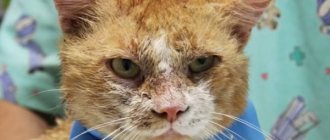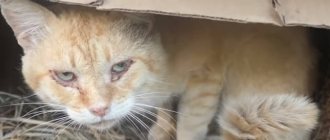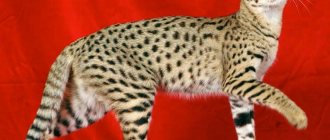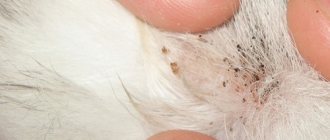Causes and solutions
There may be several reasons for exfoliating skin particles. Some factors should force the breeder to reconsider their grooming habits, as well as to improve the animal’s place of residence. Others are a reason to immediately consult a doctor.
Environmental Impacts
Factors in this group include negative aspects that in one way or another affect the condition of the pet’s skin:
- Hairless representatives of the cat family have skin that is not protected by anything. Sunburn causes necrosis of the upper layers of the dermis, their keratinization and exfoliation.
- Excessive dryness indoors leads to a lack of moisture in the upper layers of the skin. The cat develops dandruff.
- Aggressive substances have a detrimental effect on the surface of the animal’s body. Excessive care, for example, bathing your pet daily with soap or shampoo, can do nothing but harm.
Owners can eliminate some of the reasons on their own. To avoid excessive tanning, which causes the cat’s skin to peel off on its back, it is enough to lubricate the surface of the body without the animal’s fur with a special cream. You can get rid of dry air by installing a humidifier in the room and covering the hot central heating radiators with a towel.
Skin diseases
Autoimmune disorders are common in hairless Sphynx cats. Pathology, such as vasculitis, affects individuals with a delicate sensitive surface of the body.
If your cat's skin is peeling and hair is falling out, you need to think about the possibility of infection with fungi or bacteria (lichen, malassezia, trichophytosis). The initial foci of infection are localized on the upper part of the body - the head.
Worm infestations disrupt the functioning of the digestive system. This results in vitamin deficiency, dyspepsia, and vomiting. The quality of the coat deteriorates, the upper layers of the skin lose elasticity, and parts of it begin to peel off. Skin parasites, burrowing into the cat’s body, cause itching. In individuals predisposed to allergic reactions, the saliva of blood-sucking insects or mites may cause negative effects on the body. Ear mites parasitize the ear canal, the main reason for this is improper care. Signs of the disease include severe itching, inflammation near the ears, and a rise in the animal’s body temperature. The main symptom is that the skin on the cat’s ears is peeling and she constantly tilts her head to the side.
Internal pathologies
Internal conditions leading to severe peeling include:
- gastrointestinal pathologies. Due to digestive disorders, food cannot fully provide the body with vitamins and microelements. The cat begins to develop anemia, peeling skin, and hair loss;
- psycho-emotional shocks. The animal's mood changes, the pet becomes withdrawn, aggressive, and inactive. Active peeling is noticed on the stomach, head, and groin area;
- sebaceous adenitis and seborrhea are pathologies associated with disruption of the sebaceous glands. Bald patches appear to a greater extent on the caudal process, and the formation of deep scratches and ulcers is possible. All over the body, or in some places, the skin becomes greasy and peels;
- oncological diseases. The condition of the dermis and fur is greatly deteriorating. The disease is also manifested by increased hair loss, peeling of the surface layers of the body, and digestive disorders. The cat loses its appetite, it loses weight “before our eyes”;
- heredity. It is known that genetically transmitted diseases (pituitary dwarfism, ichthyosis) are accompanied by thinning of surface tissues and increased keratinization.
The list of diseases goes on. After all, there are a lot of other ailments in the world. Treatment should be carried out by a doctor in a veterinary clinic. Some pathologies cannot be treated at all; remission is maintained with the help of a properly selected diet and a course of medications.
Eczema
Eczema develops in animals due to exposure to local, infectious lesions of certain areas of the skin. The disease can be caused by lack of hygiene, parasitic infestation, vitamin deficiency, low-quality shampoos, anti-parasitic collars, violation of living conditions, stress, injuries, cuts, ulcers. Burns, frostbite, hormonal imbalance, autoimmune diseases, endocrine pathologies are common causes of eczema in pets.
Eczema often manifests itself against the background of systemic, viral, and bacterial infections. Pathology may indicate systemic failures in the pet’s body.
Symptoms
Eczema in cats can be dry or wet. When dry, the skin becomes rough, peels, turns red, and cracks. Gray-white scales appear in the affected areas.
We suggest you read: How to feed a week-old puppy
The main symptoms of wet eczema are the presence of local, constantly wet areas on the body. In the areas of damage, fluid-filled blisters, pustules, ulcers, and long-lasting ulcers are visible. The skin is very inflamed and painful.
The cat is itchy and restless. Inflammation affects first the upper and then the deeper layers of the dermis. The skin in the affected areas is hot. Activity decreases, appetite worsens, hair falls out. Possible increase in temperature, weight loss, fever.
Treatment is carried out under the supervision of a veterinarian and depends on the type of eczema, the degree, severity of the lesion, and the root cause. In therapy, antiseptic agents in aerosols, powders, lotions, anti-inflammatory, and antihistamines are used. Before applying ointments, the hair is cut around the affected areas.
Hygiene, proper coat care, the use of high-quality shampoos, and systematic treatments against ectoparasites will help to avoid the development of skin disease.
Description of possible causes
First of all, you need to pay attention that the characteristics of the breed can also play a special role. For example, Bengal cats may have peeling skin on their nose from the first months of life. As you grow older, this symptom may disappear without a trace. Great importance is paid to the accompanying symptoms of the part of the body on which peeling appears. Here is a list of the most common diseases that need to be excluded first:
Demodecosis. It is most common in adults over the age of 10 years. Serious internal diseases (chronic renal failure) and hormonal fluctuations (estrus, pregnancy) can provoke the activity of this type of tick. Often demodicosis is diagnosed after long-term use of antibiotics and operations. In other words, something must affect the immune system for the mite to begin to pathologically multiply on the skin. In this case, large bald patches may appear, inside of which there is severe peeling. There is no itching. If the process is not complicated by a secondary infection. In most cases, eliminating the root cause that provoked the activity of demodex leads to complete recovery.- Lichen. A real disaster for owners who have several animals living in their house. Ringworm is considered a highly contagious type of fungus that can even spread to humans. It is most common in cats living outdoors or in a cattery. The distinctive signs of lichen are large bald patches, inside of which the skin peels and turns red. The pet pays special attention to the affected areas, trying to lick, bite or chew them out. This causes large wounds and scratches. A secondary infection often occurs. The localization of lesions is varied, ranging from the tips of the ears to the paws. Ringworm can be confused with an allergy or
pyoderma. To confirm an accurate diagnosis, a series of studies are carried out (cytology, microscopy and culture), on the basis of which the fungal culture is determined. Most often these are dermatophytes and trichophytons, less often yeast fungi. Terbinafine and Imaverol are used as treatment. Remember that lichen can constantly recur if not treated correctly. - Peculiarity of the breed. Hairless cats have an innate predisposition to the appearance of comedones. They are formed due to excess sebum that accumulates in the hair follicle. In Sphynxes, the appearance of comedones is always accompanied by severe peeling of the skin and redness. Itching is observed only if the process is complicated by a bacterial infection or furunculosis. In severe cases, glucocorticosteroids may be used.
- Allergy. The most common cause of flaking and white dandruff in cats' fur. The affected areas also become inflamed, swollen and very itchy. Due to scratching, the process may be complicated by secondary infection. Against the background of allergies, demodicosis can also become more active, which is described in detail above. Most often, ornamental breeds suffer, in which the slightest change in diet can have a strong impact on the skin. If there is a hereditary predisposition to allergies (often found in Persians, Maine Coons, Bobtails), then even a small piece of flour or sweet food can provoke a strong reaction. Therefore, owners of such breeds
you need to carefully watch that no one feeds their pet or that the animal itself does not steal something from the table. Since the treatment is long-term, with constant relapses, which bring significant discomfort to the cat. If it is not possible to identify a potential allergen, then treatment will be symptomatic. In this case, the owner must be informed that even the complete disappearance of symptoms is not considered recovery. Since the slightest contact with an allergen can provoke an even greater reaction. - Cheyletiellosis. Another type of mite that can cause flaking in cats. Only unlike demodicosis, cheyletiella can cause discomfort to the owners (bite them). At the same time, this type of tick does not reproduce in humans, it only bites. A pet, in turn, can only be a carrier. Therefore, it is recommended to treat the cat with drops (on the withers) of Stronghold or Frontline combo 2 times every 3 weeks. If symptoms persist, then the participation of a dermatologist will be required to conduct a microscopic examination of scrapings taken from the animal's skin (scales, peeling and hair). This test will confirm or rule out the presence of a tick.
Ringworm
Ringworm is an infectious skin disease caused by the mold fungi Microsporum gypseum and Trichophyton. It can affect both animals and humans. It is our mustachioed pets who are most vulnerable to it. Infection usually occurs from close contact with a sick individual.
However, pets are just as susceptible to ringworm as their stray counterparts. The fact is that fungal spores are very resistant to various environmental conditions. They are easily transported on our shoes, clothes, and penetrate with dust into the windows of our houses. At risk of infection are animals that are in a state of immune depression, have a poor diet, young kittens under 1 year old and older animals.
Symptoms
It is important to diagnose ringworm in a timely manner, because the treatment of all skin diseases, and ringworm is no exception, usually takes a long time. The main symptoms of ringworm are:
- significant hair thinning;
- the appearance of white flakes in the fur, “cat dander”;
- Naturally, itching, the cat becomes less balanced and nervous;
- the wool loses its attractiveness, becomes greasy and crumpled;
- if the claws are damaged, they become deformed and become yellowish in color.
Treatment
Treatment of ringworm must be carried out immediately, because there is a high risk of infection for humans. In order to confidently say that it is lichen, veterinarians conduct a series of studies of skin particles. Treatment will consist of antifungal therapy, with Tiabendazole or Miconazole ointments applied topically.
Some pet illnesses can be dangerous for their owners. Skin diseases in cats that can be transmitted to humans are fungal infections that cause ringworm. It is advisable to start their treatment at an early stage. The main sign of lichen is areas of lost hair that the cat scratches all the time. Another symptom is that the skin peels, forming dandruff.
To treat lichen, antifungal drugs are used in the form of ointments, and, if necessary, tablets. If your cat has long, thick hair, it needs to be trimmed. This is done so that the ointment can be applied to the affected areas of the skin. In advanced cases, baths with sulfuric lime are prescribed.
My cat's skin is peeling, where to look for the cause?
Peeling is the formation of scales (squama), keratinized pieces of the epidermis. The separation of keratinized particles of the epidermis occurs constantly and is a normal physiological process, that is, the skin is renewed. With various skin diseases, this process intensifies. Scales can be separated either in very small (pityriasis-like) pieces or in plates. Depending on the underlying disease, the skin may be swollen, hyperpigmented, or, on the contrary, thin out and become almost transparent and reddish.
Peeling of the skin in Sphynx cats develops for many reasons, and often occurs when the air in the room where the cat lives is too dry. Let's look at the main causes of dry and flaky skin in cats.
- Sunburn. Since sphinxes do not have fur, nothing protects their skin. Their skin is quite sensitive to ultraviolet radiation, tans and “burns” quickly. It is advisable not to allow the cat to remain in direct sunlight for a long time.
- Allergic reaction to external irritants (flea saliva, chemicals, skincare products, etc.) Against the background of an allergic reaction, an inflammatory process develops and the separation of the epidermis increases;
- Fungal skin infections - Malassezia dermatitis, trichophytosis, microsporia. All of these diseases damage the skin, causing inflammation and peeling.
- Autoimmune diseases – pemphigus, vasculitis. Often found in Sphynx cats due to their particularly sensitive skin.
- Bacterial skin infections usually overlap with the primary disease, causing pyodermatitis, itching, and hyperkeratosis.
- Parasites. Despite the lack of hair, Sphynx cats are often affected by ticks and fleas, which significantly injure their sensitive skin.
- Ichthyosis is a hereditary disease accompanied by increased keratization and impaired desquamation of dead epithelium. It is quite rare in cats.
As we can see, flaking in Sphynx cats can be caused by a variety of factors, so it is necessary to make a diagnosis after a comprehensive examination of the cat. At home, if there are no other lesions on the skin besides peeling, you can try changing your skincare products and being more attentive to your cat’s hygiene. If there is no positive dynamics, try to make an appointment with a dermatologist. The doctors at our veterinary clinic will carefully examine your pet, perform a series of diagnostic tests to identify the cause of the flaking, and prescribe the optimal treatment.
Cost of treatment and prevention of skin peeling in cats and dogs of certain breeds
To prevent skin diseases in sphinxes and other “bald cats”, it is necessary to monitor their hygiene and nutrition. It is important to regularly bathe your cat with a special shampoo and wipe the skin with wet wipes that do not contain alcohol. Don't forget about vaccination and treatment for internal and external parasites.
The cost of treatment depends on the main reason for the formation of scales on the skin of sphinxes, but a medicated shampoo (from 400 rubles) will be prescribed to cleanse the skin and prevent infection of the affected areas. Further treatment is prescribed according to the diagnosis, for example, for sarcoptic mange, three times treatment against parasites is necessary (course cost from 300 rubles)
We work for you 24 hours a day, 7 days a week. We are located at:
Krasnoyarsk, Partizana Zheleznyaka str. 9g; +7 (391) 2-179-779
Classification of skin diseases
Most often, skin diseases occur in cats that are regularly outdoors. But animals that are not outdoors also run the risk of contracting the disease. Skin diseases are divided into two types: parasitic and non-parasitic infections. Various allergic reactions often appear on the animal's body. You should be especially wary of the formation of sores on the head of cats.
Skin diseases require serious and long-term treatment
Parasitic infections include:
Cat's skin is peeling: where to look for the cause?
Every person, when getting a pet, must remember that monitoring the health of a new family member is one of his main responsibilities. Any deviations from the norm should begin to be treated when the first symptoms are identified. Those who have encountered lichen in cats will confirm that you can be tortured to remove it, especially if there are small children in the house.
When a cat's skin peels and hair falls out, this is one of the most obvious signs of many skin diseases, as well as various diseases of the internal organs. The article will discuss the most popular causes and symptoms of such diseases, as well as methods of treating them.
Psychogenic alopecia
Due to thorough and prolonged licking, cats may develop bald spots. This behavior means that the pet is stressed. Sometimes baldness occurs due to allergies and fungal diseases.
First you need to check your pet for parasites and make sure there is no hypersensitivity to external irritants.
Therapy consists of eliminating the factors that caused emotional distress in the cat. Sometimes a mechanical barrier is required to restrict the pet from licking.
Signs of the described deviations
Peeling of the skin is accompanied by the appearance of dandruff throughout the animal's body. Most often, the main areas of damage are the back and the area near the tail. The main signs of peeling skin and hair loss include:
- Excessive thinning or thickening of the animal’s skin;
- Necrosis of a large area of the stratum corneum of the skin caused by pathologies of an internal or external nature;
Almost always, flaking and baldness are accompanied by itching, the presence of which affects the condition of the pet’s skin - it worsens significantly. In addition, the entry of bacteria into scratched wounds leads to the development of inflammatory processes on the skin.
Causes and symptoms of this condition
The reasons why a cat's skin peels can be divided into internal and external factors.
External causes cause irritation of the skin upon direct contact with them. These factors include:
- Physical. Sudden changes in temperature, excess sun, lack of humidity and poor ventilation of the room often lead to active peeling of the skin or hair loss.
- Chemical. Poor-quality collars, litter, shampoos and other cosmetic products for cat skin care can lead not only to excessive peeling of the skin, but also cause the development of dermatitis or eczema.
- Infectious. All fungal infections are accompanied by hair loss in the initial stages, and when the condition worsens, they lead to peeling of the skin. One of the most common diseases of this type is lichen; these symptoms are also characteristic of diseases such as dermatitis and demodicosis. The presence of any parasites almost always leads to the appearance of an excessive amount of dandruff, since the sebaceous glands of the cat or cat malfunction.
- Mechanical. Peeling may occur at the site of a recent injection or in the presence of abrasions or scratches.
In most cases, it is enough to remove the root cause to rid your pet of flaking.
Internal causes are directly related to unbalanced nutrition, complications from stress and diseases of the digestive tract. Let's take a closer look at each of these factors:
- Problems in the digestive system. Most often, a cat's skin peels off on the back and other parts of the body during the secondary stage of the disease. First of all, problems with stool, sudden weight loss, apathy and refusal to eat are observed. Such signs may signal the development of a tumor in the digestive organs.
- Incorrectly selected diet. Excessive presence of carbohydrates in the daily diet, lack of essential vitamins and minerals, leads to vitamin deficiency and the development of allergies, which causes flaking and contributes to baldness.
- Psychological disorders. The pet suffers from mood swings, in addition to hair loss and flaking, severe itching and ulcers may occur.
Often the cause of the described problem lies in various endocrine diseases, hereditary pathologies and sebaceous adenitis, which, in addition to the indicated symptoms, is characterized by the destruction of the sebaceous glands.

